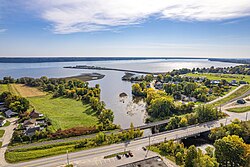Portneuf River (Capitale-Nationale)
River in Quebec, Canada From Wikipedia, the free encyclopedia
River in Quebec, Canada From Wikipedia, the free encyclopedia
The Rivière Portneuf is a tributary of the north shore of the Saint-Laurent river, crossing the municipalities of Saint-Raymond, Pont-Rouge, Sant-Basile and Portneuf, in the Portneuf Regional County Municipality, in the administrative region of the Capitale-Nationale, in the province of Quebec, in Canada.
| Portneuf River | |
|---|---|
 | |
| Native name | Rivière Portneuf (French) |
| Location | |
| Country | Canada |
| Province | Quebec |
| Region | Capitale-Nationale, Mauricie |
| Regional County Municipality | Portneuf Regional County Municipality |
| Municipalities | Pont-Rouge, Saint-Basile |
| Physical characteristics | |
| Source | Sept Îles Lake (Saint-Raymond) |
| • location | Saint-Raymond, MRC Portneuf Regional County Municipality, Capitale-Nationale, Quebec, Canada |
| • coordinates | 46°56′02″N 71°44′48″W |
| • elevation | 209 m (686 ft) |
| Mouth | Saint Lawrence river |
• location | Portneuf |
• coordinates | 46°56′02″N 71°48′24″W |
• elevation | 5 m (16 ft) |
| Length | 55 km (34 mi) |
| Basin features | |
| Tributaries | |
| • left | (Upward from the mouth) Le grand Ruisseau, Saint-Jacques River, Savane stream, Froid stream, Blanche River, the outlet of Sergent Lake, unidentified stream, unidentified stream, discharge from two unidentified lakes. |
| • right | (Upward from the mouth) Ruisseau chez Jess, rang Saint-Charles stream, Gagné stream, Chaude River, Rivière des Sept Îles, Morasse stream, Lac BP outlet, unidentified stream, unidentified stream, discharge from two unidentified lakes. |
The Portneuf river valley is mainly served by route 138, chemin Neuf, chemin du rang Saint-Angélique, chemin du Grand Rang (route 365), chemin de Bourg-Louis, chemin de la Grande Ligne and chemin du Lac Sept-Îles-Sud.[1]
Except for the segments passing through a hamlet of Saint-Raymond, in the village of Saint-Basile and the village of Portneuf, agriculture and forestry constitute the main economic activities of the sector.
The surface of the Portneuf River (except the rapids areas) is generally frozen from the beginning of December to the end of March; safe circulation on the ice is generally done from the end of December to the beginning of March. The water level of the river varies with the seasons and the precipitation.
The Portneuf River is located on the north shore of the Saint-Laurent river, halfway between Trois-Rivières and Quebec, more precisely between the hydrographic slopes the Sainte-Anne River (to the west) and the Jacques-Cartier River (to the east).
The Portneuf River draws its source from Sept Îles Lake (length: 4.2 kilometres (2.6 mi); altitude: 209 metres (686 ft)) which discharge from the southwest.[2] The resort area is very dense around this lake.
From the mouth of Lac Sept Îles, the current of the Portneuf River descends on 55 kilometres (34 mi), with a drop of 204 metres (669 ft), according to the following segments:
Upper course of the Portneuf river (segment of 20.1 kilometres (12.5 mi))
Intermediate course of the Portneuf river (segment of 20.1 kilometres (12.5 mi))
Lower course of the Portneuf river (segment of 14.8 kilometres (9.2 mi))
Some infrastructures have been erected in this hydrographic slope notably mills (saw and flour) and shipyards (in the lower zone). Two disused dams are listed in the municipalities of Portneuf and Notre-Dame-de-Portneuf.
A quay of one km in length, was built on the Saint-Laurent river during the years 1956 to 1958 by the city of Portneuf west of the mouth of the Portneuf river. This Portneuf wharf points southeast toward Pointe-Platon (Lotbinière Regional County Municipality), located on the south shore of the St. Lawrence River. This quay is a gathering place for local festivities.
The name of this river is linked to the seigniory of Portneuf which it crosses before flowing into the Saint Lawrence river. Although this seigniory was allotted in 1636, the act of the concession was confirmed in 1647.[3]
The toponym "Rivière Portneuf" was formalized on December 5, 1968, at the Place Names Bank of the Commission de toponymie du Québec.[4]
Seamless Wikipedia browsing. On steroids.
Every time you click a link to Wikipedia, Wiktionary or Wikiquote in your browser's search results, it will show the modern Wikiwand interface.
Wikiwand extension is a five stars, simple, with minimum permission required to keep your browsing private, safe and transparent.